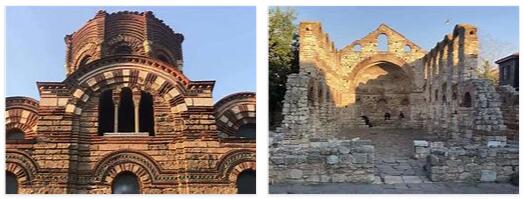The Black Sea city of Nessebar, connected to the mainland by a dam, is one of the oldest cities in Europe. The world heritage includes buildings from ancient times and from the Middle Ages to residential architecture from the 18th and 19th centuries.
Old town of Nessebar: facts
| Official title: | Old town of Nessebar |
| Cultural monument | Only parts or ruins of the 40 sacred buildings remain, including the New Metropolitan Church of St. Stephan, the Church of St. John the Baptist, those of St. Todor, that of St. Paraskeva, St. Johannes Aliturgetos and St. Archangel Michael; Development of the streets in the romantic national style; Houses with protruding, wood-clad bay windows and wide eaves like the houses of Ivan Markov and Christo Kotschev |
| continent | Europe |
| country | Bulgaria |
| location | Nessebar, on a 0.12 km² peninsula |
| appointment | 1983 |
| meaning | important evidence of Hellenistic architecture in connection with the medieval sacral and urban architecture of the 19th century in the so-called Plovdiv style |
Old town of Nessebar: history
| 2nd century BC Chr. | Thracian settlement |
| 72 BC Chr. | Conquest by Roman associations |
| 680 | raised to the diocese |
| End of the 9th century | Church of St. John the Baptist |
| 13./14. Century | Pantocrator Church with ceramic decoration |
| 1599 | The iconostasis of the New Metropolitan Church is well worth seeing |
| 1913 | Severe earthquake damage to the Johannes Aliturgetos Church |
An open-air museum of Bulgarian history
The contrast could hardly be greater. From Sunny Beach, one of the most popular seaside resorts in Bulgaria with its kilometer-long sandy beach, Nessebar is easy to see with the naked eye. From there, the small town of Nessebar can be easily reached by bike; the short way also means immersion in another world, a unique chapter of Bulgarian history featured on thesciencetutor. The “open-air museum” Nessebar, located on a peninsula, is connected to the mainland by a narrow, 400-meter-long dam. Here, too, the blessing – but for some also the curse – of mass tourism has left its mark: stalls, restaurants and cafes make it clear that the residents want to participate in the flow of visitors. Yet: With every step through the narrow streets the visitor opens a new page of the rich Bulgarian history. Stone witnesses of Greek supremacy lie close to the numerous ruins of medieval churches and the very interesting houses from the 18th and 19th centuries with their protruding upper floors. Even at the only entrance to the peninsula, the remains of mighty walls and towers impress – if they could speak, they would tell stories from the 5th century BC, but also the 14th century AD.
The fortification walls of the Greeks were strengthened and expanded by the Byzantines, in some cases the walls reached a thickness of four meters. The well-fortified city offered safe protection for a long time, the best prerequisite for its economic prosperity. Greek settlers developed the former Thracian settlement into a flourishing community, which they named Mesambria. As numerous finds and historical sources attest, the city played an important mediator role between the Greek world and the Thracian tribes of the hinterland, trade relations extended to Asia Minor and Egypt. It is thanks to the Roman takeover of the city without a fight that the traces of Hellenism have been preserved to this day.
During almost the entire history of the city, Nessebar played an important military and, above all, commercial role in this region. It brokered trade in the Balkans and the Black Sea and had a powerful war and merchant fleet. During the Middle Ages, Nessebar’s alternating membership of the Byzantine and Bulgarian empires did no harm to its economic power. Spiritual life flourished, as can be seen from the numerous remains of medieval church buildings. Ruins of four large basilicas have been preserved from the early Byzantine era. Above all, the former main church, the old metropolitan church with its rows of arcades, is still impressive today.
The churches that were built in the following centuries are artistically and aesthetically even more attractive. Despite all the destruction and all decay: the alternation of white and brown natural stone with red brick, often arranged in alternating stripes, is still convincing in its aesthetic effect. Niches and graphic patterns made of brick, which are often only used for decoration, loosen up the facades of the church buildings and give them a lively appearance. The rhythm of the facades is reinforced by the frequent use of glazed ceramics, which, in the form of colorful decorative ribbons, pans and rosettes, cast their very own shine on the facades in the light of the shining sun.
But Nessebar is by no means a lifeless museum of bygone eras. People live and work here, offer women their lace work, busily crochet, sitting in front of their houses. The everyday life of the present merges with the stone witnesses of a rich past.
